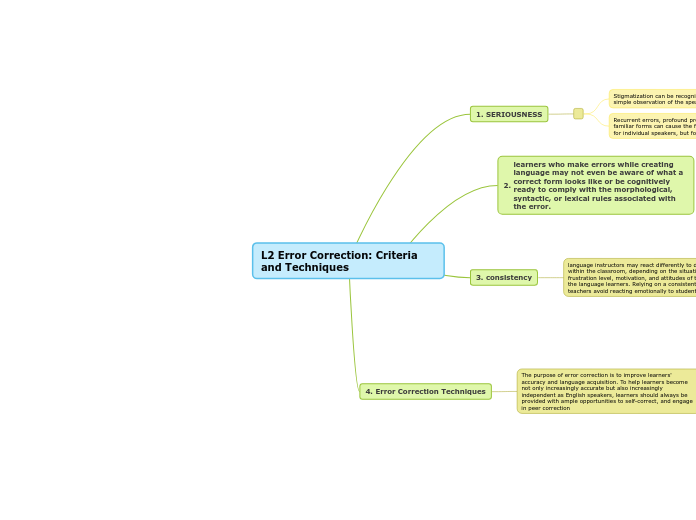L2 Error Correction: Criteria and Techniques
SERIOUSNESS
Stigmatization can be recognized by the teacher through simple observation of the speaker and fellow classmates
Recurrent errors, profound pronunciation errors, or errors of familiar forms can cause the frustration level to rise, not only for individual speakers, but for the entire class.
learners who make errors while creating language may not even be aware of what a correct form looks like or be cognitively ready to comply with the morphological, syntactic, or lexical rules associated with the error.
consistency
language instructors may react differently to different students within the classroom, depending on the situation, the frustration level, motivation, and attitudes of the teacher and the language learners. Relying on a consistent approach helps teachers avoid reacting emotionally to students' errors
Error correction can assist language learners to acquire structures in the TL if the language teacher consistently applies these criteria: (a) the learner's amount of exposure to the language structure or form, (b) the seriousness of the error, (c) whether or not the error has impaired communication significantly, (d) the frequency of the error, and (e) the needs of the students.
Error Correction Techniques
The purpose of error correction is to improve learners' accuracy and language acquisition. To help learners become not only increasingly accurate but also increasingly independent as English speakers, learners should always be provided with ample opportunities to self-correct, and engage in peer correction
Peer correction is especially important because it takes some of the focus off of the teacher, and it has been shown to be effective
Omaggio warns that this technique may not be effective, especially if the teacher does not reassess the student's comprehension to see if he or she has realized that the response has been corrected by the teacher. Students who have confidence with their own self-correction techniques will probably be the only ones who benefit from this kind of correction.
Self-correction with the teacher's help is an excellent way to address errors. The first type Omaggio offers is pinpointing, whereby the teacher localizes the error by repeating the learner's utterance up until the point where the error has occurred, and exaggerates the word which has preceded the error with a rising intonation.
rephrasing a question. This can be used when a student fails to answer or answers incorrectly without confidence. Generally, the rephrased question is a reduced form of the original.
